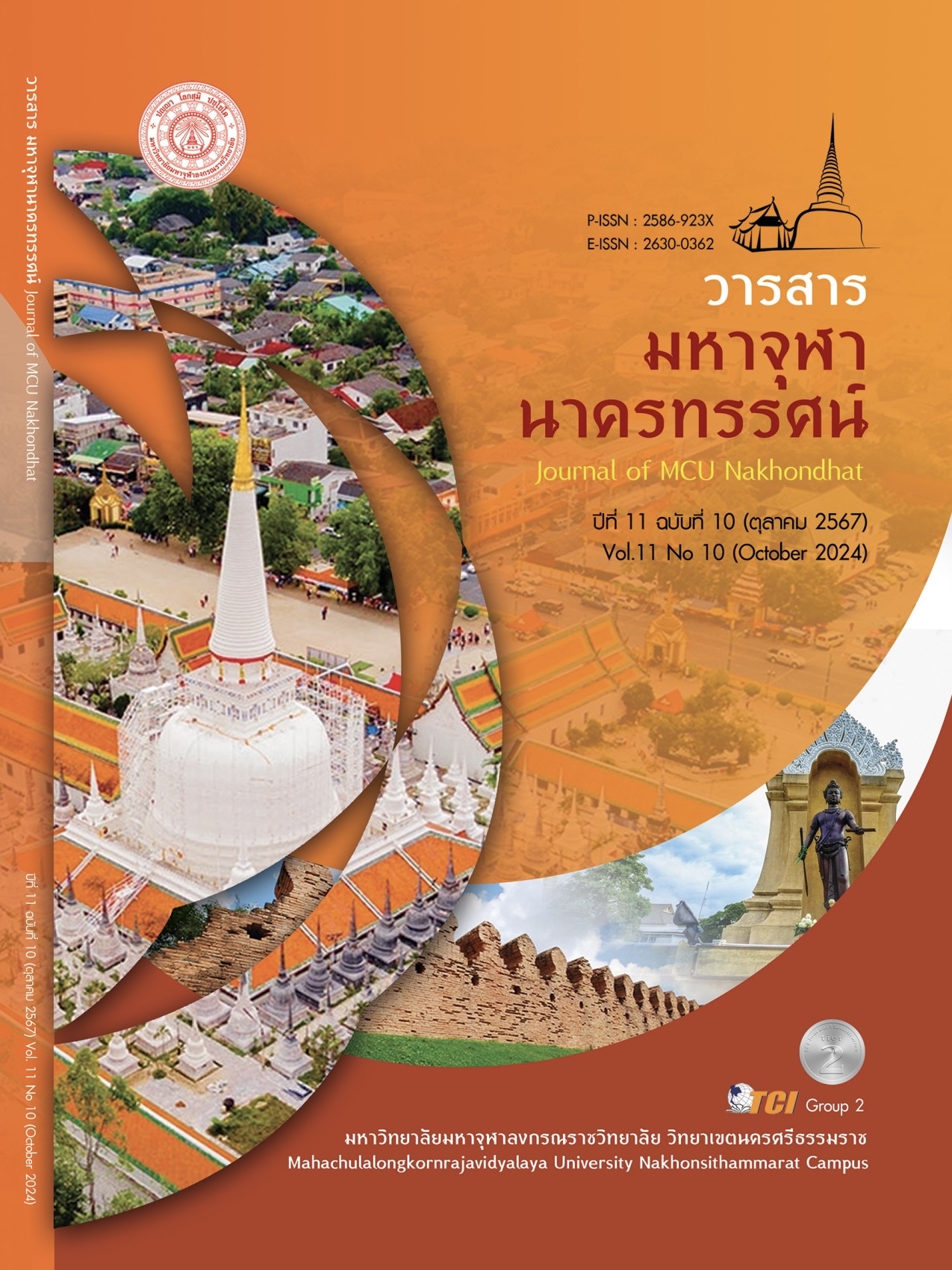การประยุกต์ใช้หลักสังคหวัตถุ 4 ในการพัฒนาคุณภาพชีวิต ของชุมชนวัดสามัคคีธรรม อำเภอคุระบุรี จังหวัดพังงา
Main Article Content
บทคัดย่อ
บทความวิจัยนี้มีวัตถุประสงค์เพื่อ 1) ศึกษาแนวคิดเกี่ยวกับการพัฒนาคุณภาพชีวิตของชุมชนวัดสามัคคีธรรม อำเภอคุระบุรี จังหวัดพังงา 2) ศึกษาหลักสังคหวัตถุ 4 ที่ปรากฎในคัมภีร์พระพุทธศาสนาเถรวาท และ 3) ประยุกต์ใช้หลักสังคหวัตถุ 4 ในการพัฒนาคุณภาพชีวิตของชุมชนวัดสามัคคีธรรม อำเภอคุระบุรี จังหวัดพังงา เป็นการวิจัยเชิงคุณภาพ ผู้วิจัยสำรวจและเก็บข้อมูลโดยการสัมภาษณ์เชิงลึก โดยนำข้อมูลที่ได้มาวิเคราะห์ ประมวลความ สรุปผล และนำเสนอในรูปแบบการเขียนบรรยายเชิงพรรณนา ผลการวิจัยพบว่า 1) แนวคิดเกี่ยวกับการพัฒนาคุณภาพชีวิต เป็นการพัฒนาที่สอดคล้องกับความต้องการของมนุษย์ 3 ด้าน คือ 1.1) ด้านกาย ได้รับปัจจัย 4 ที่พอเพียงต่อการดำรงชีวิต 1.2) ด้านอารมณ์ รู้จักปรับตัวมองโลกในแง่ดี ไม่เครียด วิตกกังวล สามารถควบคุมอารมณ์ตนเองได้ ไม่เป็นคนขาดสติ และ 1.3) ด้านสังคม มีความพร้อมในการอยู่ร่วมกันกับบุคคลอื่น รวมทั้งได้รับการยอมรับจากสังคม 2) สังคหวัตถุ 4 ที่ปรากฏในคัมภีร์พระพุทธศาสนา เถรวาท เป็นหลักการสงเคราะห์ซึ่งกันและกัน ประกอบด้วย ทาน การให้ ปิยวาจา การพูดจาไพเราะ อัตถจริยา การบำเพ็ญประโยชน์ และสมานัตตตา วางตนเหมาะสม 3) การประยุกต์ใช้หลักสังคหวัตถุ 4 ในการพัฒนาคุณภาพชีวิตของชุมชนวัดสามัคคีธรรม อำเภอคุระบุรี จังหวัดพังงา ด้านกาย จะช่วยให้สร้างสังคมที่มีความสุขและสุขภาพดี ด้านอารมณ์ จะช่วยสร้างความมั่นคงทางจิตใจ เสริมสร้างความสัมพันธ์อันดีในสังคม ด้านสังคมจะช่วยกระชับความสัมพันธ์อันดีในชุมชนและสร้างสังคมที่ยุติธรรมและสงบสุข นอกจากจะนำสันติสุขมาสู่จิตใจของเราแล้ว ยังส่งผลให้มีความสามัคคีและพัฒนาชีวิตให้ดีขึ้นอีกด้วย
Article Details

อนุญาตภายใต้เงื่อนไข Creative Commons Attribution-NonCommercial-NoDerivatives 4.0 International License.
เอกสารอ้างอิง
พระกรัณรักษ์ เขมจาโร (ร่มเงิน). (2558). การพัฒนาคุณภาพชีวิตของประชาชนตามการบริการของเทศบาลตำบลป่าตุ้ม อำเภอพร้าว จังหวัดเชียงใหม่. ใน วิทยานิพนธ์พุทธศาสตรมหาบัณฑิต สาขาวิชารัฐประศาสนศาสตร์. มหาวิทยาลัยมหาจุฬาลงกรณราชวิทยาลัย.
พระครูกิตติพลาธร (กัด กิตฺติธโร). (2561). รูปแบบการพัฒนาชีวิตด้วยหลักสังคหวัตถุ 4 ของกลุ่มชาติพันธ์ ในจังหวัดศรีสะเกษ. ใน วิทยานิพนธ์พุทธศาสตรดุษฎีบัณฑิต สาขาวิชาพระพุทธศาสนา. มหาวิทยาลัยมหาจุฬาลงกรณราชวิทยาลัย.
พระครูวินัยธรอำนาจ พลปญฺโญ. (2561). ปัญหาและหลักการพัฒนาคุณภาพชีวิตในศตวรรษที่ 21. วารสารพุทธมัคค์ ศูนย์วิจัยธรรมศึกษา สำนักเรียนวัดอาวุธวิกสิตาราม, 3(2), 25-35.
พระณเดช ปคุโณ (สมบูรณ์พร้อม). (2564). แนวทางการพัฒนาชุมชนตามหลักสังคหวัตถุ 4 ของประชาชนชุมชน OTOP บ้านบกหวาน ตำบลค่ายบกหวาน อำเภอเมืองหนองคาย. ใน วิทยานิพนธ์พุทธศาสตรบัณฑิต สาขาวิชาพระพุทธศาสนา. มหาวิทยาลัยมหาจุฬาลงกรณราชวิทยาลัย.
พระธรรมปิฎก (ป. อ. ปยุตฺโต). (2553). พุทธวิธีแก้ปัญหา เพื่อศตวรรษที่ 21. กรุงเทพมหานคร: โรงพิมพ์ชุมชนสหกรณ์การเกษตรแห่งประเทศไทย จำกัด.
พระพรหมคุณาภรณ์ (ป.อ.ปยุตฺโต). (2549). พระพุทธศาสนาพัฒนาคนและสังคม. (พิมพ์ครั้งที่ 6). กรุงเทพมหานคร: โรงพิมพ์บริษัทสหธรรมิก จำกัด.
มหาจุฬาลงกรณราชวิทยาลัย. (2539). พระไตรปิฎกภาษาไทยฉบับมหาจุฬาลงกรณราชวิทยาลัย. กรุงเทพมหานคร: โรงพิมพ์มหาจุฬาลงกรณราชวิทยาลัย.
วันชัย เมธาอภินันท์ และคณะ. (2565). การสร้างสุขตามหลักสังคหวัตถุ 4 ของชุมชนหนองสองห้อง จังหวัดขอนแก่น. วารสารวิชาการธรรมทัศน์, 18(3), 271-272.
สมเด็จพระอริยวงศาคตญาณ (วาสน์ วาสโน). (2528). สังคหวัตถุ 4. กรุงเทพมหานคร: โรงพิมพ์มหามกุฎราชวิทยาลัย.
อัจฉรา ชลายนนาวิน. (2562). แนวคิดองค์ประกอบชุมชนและการพัฒนาชุมชนอย่างยั่งยืน กรณีศึกษาหมู่บ้านวัฒนธรรมบ้านไทดำ บ้านนาป่าหนาด จังหวัดเลย. วารสารรัฏฐาภิรักษ์, 61(1), 45-55.


